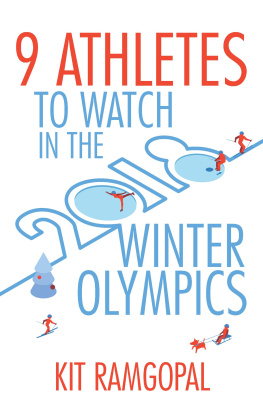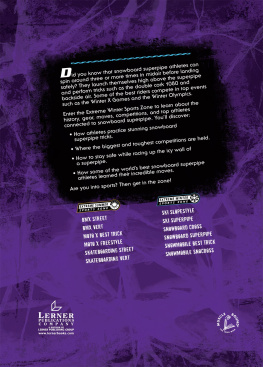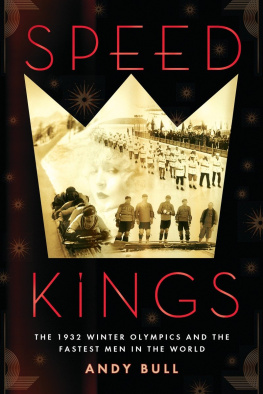9 ATHLETES TO WATCH
IN THE 2018 WINTER OLYMPICS
By
KIT RAMGOPAL
This edition published by Dreamscape Media LLC, 2018
1417 Timberwolf Drive, Holland, OH 43528
877.983.7326

TABLE OF CONTENTS
Foreword
The 2018 Winter Olympics and Paralympic Games will take place from February 9th through the 25th in PyeongChang, South Koreaa sleepy ski town in South Koreas Northern Gangwon Province. While each athlete across the 102 different Winter Olympics events will arrive in PyeongChang with their own compelling backstory, we have chosen to profile nine of them here. These nine athletes are not simply medal contenders; rather, each one illustrates a connection to a larger story driving the dialogue at the 2018 Winter Games.
Some athletes, like Ashley Wagner and Sven Kramer, illuminate hidden social phenomena in sports, from the prevalence of eating disorders in figure skating, to the Netherlands strange obsession with speed skating. Other athletes may stand at the junction of controversies regarding the 2018 Games, such as the Russian doping scandal or the NHLs ban on its players participation. Oksana Masters survived a Ukrainian orphanage and birth defects related to the Chernobyl disaster, while North Korean figure skating pair Tae Ok Ryom and Ju Sik Kim hope desperately that their government will let them compete on an Olympic rink. Others, like Lindsey Vonn and Lizzy Yarnold, are record-smashing legends in their respective sports of downhill skiing and skeleton.
Their nine stories comprise a unique window into the Olympics, which has become far more than an athletic competition. The Olympics is one of the few times when the global community gathers for an apolitical, positive reason: the mutual celebration of sports. The survival of the Olympics from ancient times to our present day is a testament to the universal appeal of athletics. Sports generate a visceral type of joy, a shared value irrespective of nationality. The history of the Winter Games is full of euphoria-inducing upsets, from tiny nations triumphing over global giants to a rag-tag American hockey team of college players beating the U.S.S.R. during the Cold War. During the Olympic opening ceremonies, the differences between nations never seems threatening, only colorful.
The stories of these nine competitors Ashley Wagner, Mark McMorris, Martin Sundby, Oksana Masters, Sven Kramer, Lizzy Yarnold, Ilya Kovalchuk, Lindsey Vonn and the figure skating duo of Tae Ok Ryom and Ju Sik Kimconverge to paint a portrait of our collective humanity in 2018. Despite facing struggles and controversies worlds apart, they all race toward the same end goal: the highest point on the Olympic podium.
Ashley Wagner
Figure Skating, USA
Ashley Wagner glitters in red as she glides across the ice, preparing for her 11th Grand Prix Figure Skating Final.
As the music for her free skate starts, her body blossoms into a twirl as a violin melody from Moulin Rouge echoes against the ice rink walls. Watching Wagner skate is like watching a pinwheel of pearl-white and cardinal redexpressive white arms, red sequined dress, glistening white ice, ruby-red lips, pearly white smile. Heading into the 2018 PyeongChang Winter Olympics at age twenty-six, she is ten years older than the reigning U.S. national champion, Karen Chen.
Her comparatively advanced age shows in the maturity, artistry, and elegance of her skating. She can skate to a love story like a woman who has experienced real love, not an aerodynamic teenager with a mother still applying her hair gel.
As the music intensifies, Wagner follows suit. She nicks the tip of her skate blade into the ice and rockets into a triple loop. She tilts her ankles inwards, her frame decomposing into a bent-leg layover camel spin, arms extended above her head.
Six triple jumps later, she skates off the ice. A slight parting of the lips and a barely perceptible quickening in the rise and fall of her chest are the only indications of the fatigue that comes from mercilessly throwing her body around on the ice for four minutes.
She skates off of the ice and rests on the bench while waiting for her score. Its a 122.37a free skate victory that puts her at third place. She finishes ahead of the rest of the U.S. competitors, including Chen.
Wagner has become a staple of U.S. womens figure skating. Everyones used to seeing her on podiums, though theyre increasingly surprised to be doing so.
Longevity is rare in this sport, Wagner admits. Sometimes I feel like I'm the locker room mom.
Wagner knows shes past her primein figure skating terms, anyway. The ideal age range for most skaters is from 15 to 18. According to Wagner, even 20 is a stretch. Yet, Wagner is undeterred by such norms. She was 22 when she competed in her first Olympics, so shes accustomed to being an outlier.
Skating caters to a very young body type, Wagner admitted. Every single day we are pounding our joints and our bodies into the ice. In heavy training season, there is not a day where I wake up and I'm bushy-tailed and ready to go. You don't get a sense of total recovery. But I think, as an elite athlete, that's the feeling you get hooked onto wake up and to have your muscles be stiff and sore and have to go in and start all over again. It's that grind that I think a lot of elite athletes obsess over.
Wagner has been obsessing for over two decades, and its taken her to three different Winter Olympics. By PyeongChang in 2018, she will be the oldest U.S. female figure skating athlete since 1924.
And Im really proud of that, Wagner said. And its because Im so freakin stubborn.
I think that if anyone tells you that theyve been that hungry every single day of their career, theyre not being honest, Wagner said. You have days where you dont want to train. I mean, Ive been skating for 22 years, this absolutely gets old. But its one of those things where I set a goal when I was six-, seven-years-old and I owe it to that little girl to see this through.
At six-years-old, Ashleys mother gave her an ultimatum to choose between ballet and figure skating. Wagner chose figure skating, as she wasnt going to do anything in pink shoes.
I grew up a total tomboy; I was not in this for the spandex and the sparkles, Wagner said. What really attracted me to the sport was the speed and the feeling of the flow on the iceit's like you're flying.
Wagner was born in Heidelberg, Germany, where her father was stationed as a Lieutenant Colonel at the U.S. Army Base there. The toughness she absorbed growing up as an army child deserves at least partial credit for her skating resilience.
My dad was tough as nails, but you know what? He made me tough as nails, Wagner said. If anything ever went wrong, or if I had a bad day, I was never allowed to feel sorry for myself. My dad would just tell me to not be a wimp. That might not sound like the nicest parental approach [laughing], but that's what most kids need to hear these days.
She and her younger brother Austin moved around for most of her childhood. Home was many different places growing up, including Germany, California, Alaska, Kansas, Washington State, and Virginia. Despite frequent relocation and a busy professional figure skating career, Wagners mother, an ex-schoolteacher, always made public education a priority. While many young professional skaters turn to home-schooling, Wagner always stayed in school. It wasnt until her senior year of high school that she had to take some online classes to keep up her studies while training in Delaware.










